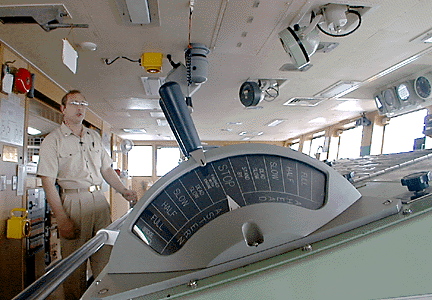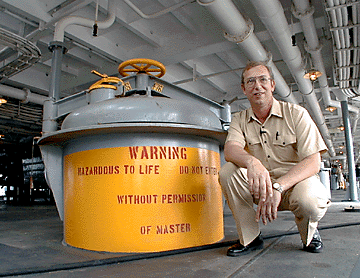


Navy fleet oiler
makes home at
Pearl Harbor
Automated refueling allows
By Gregg K. Kakesako
the ship to use a smaller crew
and stay at sea for 270 days
Star-BulletinFor the first time in two decades, merchant mariner Robert Sylvester will be able to savor the luxury of going home to his family in Kaneohe each night that his ship is in port.
"I spent the best part of the last 20 years in Asia," said Sylvester, one of 66 civilian mariners assigned to the USNS John Ericsson, a Navy Military Sealift Command fleet oiler that arrived here last week and will be based at Pearl Harbor.
Sylvester is the first officer on the 677-foot oiler -- the sixth of 16 Henry J. Kaiser-class ships that deliver petroleum, oil, water and lubricants to Navy vessels at sea.
He boarded the Ericsson in Portland, Ore., last month when it was brought back into service to replace the USS Cimarron and USS Willamette.

The Navy maintains that using civilian crews on noncombatant vessels like the Ericsson will save taxpayers money.This is because crews are smaller and can stay at sea longer, said Military Sealift Command spokeswoman Tricia Larson.
For example, refueling operations are totally automated, and one person can now maintain the ship's liquid transfer system, replacing 50 deck hands who used to manually turn valves on older vessels, said Lee Apsley, the Ericsson's cargo officer.
From his cargo control console on the ship's fifth level, Apsley can electronically monitor the operations of 24 cargo tanks, whose capacities range from 1,000 to 8,000 barrels of jet fuel, diesel fuel, lubricants and water.
The Ericsson's crew has 66 civilians and 24 Navy personnel, mainly communications specialists.
The Cimarron and the Willamette each has 370 sailors and officers.
There are no weapon systems on Military Sealift Command oilers, which means they do not need Navy personnel to operate them, Larson said.

For protection, the Ericsson will depend on the battle group it operates with.In addition, civilian crews will be able to spend an estimated 270 days at sea, compared with the 180-day average of crews on standard Navy oilers, she added.
The Ericsson is one of six civilian-crewed oilers which are crucial links of the Pacific Fleet's at-sea refueling program.
Ships like the Ericsson, Larson added, provide the logistical support needed to keep Navy ships at sea, on station and combat-ready -- all vital elements in maintaining the Navy's forward presence.
Besides oilers, the Military Sea-lift Command today operates more than 105 noncombatant civilian-crewed ships, including ocean-going tugs, ammunition ships and hospital ships.
Commissioned in 1991, the Ericsson was taken off active duty five years later and berthed on the Willamette River near Portland.
It is one of three Military Sealift Command oilers recently reactivated to replace five Navy oilers that are being decommissioned.
Besides the Cimarron, which was taken out of service in December, and the Willamette, which will be decommissioned in April, the Navy is retiring the Merrimack, the Platte and the Monongahela in the Atlantic.
The Atlantic-based oilers will be replaced by the USNS Leroy Grumman and USNS Lenthal.
The Ericsson is named for John Ericsson, a 19th-century inventor and naval architect best known for designing the ironclad Monitor during the Civil War.